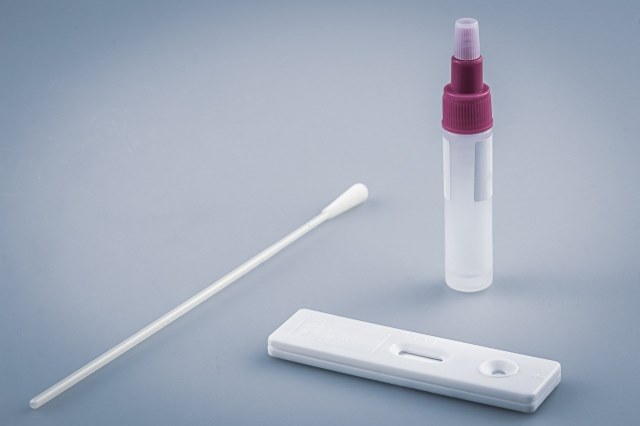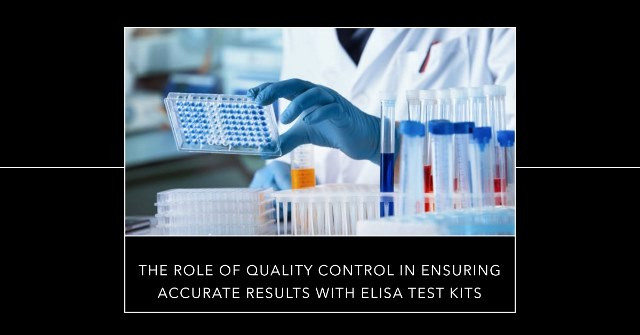The Role of Quality Control in Ensuring Accurate Results with Elisa Test Kits
Sep 1st 2023
It is an innate duty of scientists to perform rigorous experiments. General Quality Control (QC) is a process that examines testing quality to identify and remove errors. Finding and correcting mistakes should usually occur before any study or trial reaches a crucial point. This is why a flaw in an Elisa kit or its use may have costly outcomes for the user.
In a perfect world, laboratory results would be accurate every single time. We have learned from erroneous COVID-19 testing that it is nearly impossible to guarantee this level of quality. Even when 99% of the results are correct, the remaining 1% can have devastating effects.
Therefore, Quality Control is consistently prioritized as an essential component of day-to-day operations at cutting-edge research institutions that use Elisa kits in their laboratories. This is because the facilities can continually maximize reproductivity.
This post analyzes the roles of quality control and assurance in enhancing quality results in Elisa test kits.
The Fundamentals of Immunoassay Quality Control

For results to inspire trust and drive research ahead, Elisa's data collection must be rigorous, reproducible, and dependable. Since different businesses do not validate their assays to the same level, it is essential to have a solid understanding of the various criteria for accuracy.
These criteria include:
Consistency

Elisa kits guarantee uniformity from lot to lot, which is essential for conducting ongoing research. Each component of the kit and the finished product undergo rigorous quality control checks to guarantee that the standard curves, background, and sample values remain intact.
Variability over time caused by variations in protein immunoreactivity can be avoided with the help of master calibration. During the development of the assay, a master calibrator is created, and each newly produced standard lot is measured against it. With these and other quality assurance procedures, ensure that results are consistent and repeatable across kit batches.
Specificity
Immunoassays can reliably measure the target analyte, allowing you to have faith in your findings while advancing your research. By their very nature, immunoassays can be tampered with by different parts of complicated samples such as plasma or serum. These interferences have both positive and negative features, but they can all lead to incorrect readings.
The assay producer is responsible for spotting and fixing such issues, but not all firms can be trusted. Eliminating false positives and negatives is essential to achieving the desired level of specificity in an Elisa kit test.
Spike Recovery
Recovery, sometimes known as spike recovery, is a metric used to evaluate the accuracy of Elisa kit tests. Analysis of spike recovery can be used to estimate the amount of analyte in an assay, and a spike recovery analysis can estimate the possibility of interference from other sample components. Assays from the best Elisa Kit Manufacturers can be performed with peace of mind because they have been optimized for recovery for different validated sample classes.
During spike recovery, the endogenous sample, like serum or plasma, is spiked with a concentrated recombinant protein that serves as the standard. The Control Spike is a sample in which the same quantity of recombinant protein has been added to a diluent.
When normalized for endogenous noise, the complex sample spike should produce the same readout as the control spike. 100% is the optimal percentage. Under-recovery, defined as a percentage below 70–80% based on the assay, indicates that your sample somehow interferes with the assay. These are tailored for peak performance, notwithstanding the difficulty of attaining satisfactory recovery across every analyte when multiplexing.
Linearity of Dilution
Another crucial component of the accuracy and specificity of immunoassays is the linearity of dilution (also known as spiked linearity or natural linearity). When tests are performed at different dilutions, you must always get the same concentration when calculating back.
This ensures consistent results. It is common for sample values to rise with increasing dilutions if the matrix of the sample needs to be appropriately accounted for. If you dilute the sample, the interference factors will likewise dilute out.
This will make the target analyte more readily available, increasing the target analyte's concentration. Natural linearity is achievable by performing a 5-fold serial dilution if your sample contains significant endogenous levels.
Spiked linearity is a term that's typically used to describe a situation in which endogenous levels are less than expected and recombinant protein is added to a sample before the sample is diluted.
Factors Influencing the Reliability and Precision of Elisa Test Results
Elisa test dependability is the capacity to deliver consistent, high-quality results. A dependable enzyme-linked immunosorbent assay (ELISA) test yields the same findings repeatedly using the same sample under identical circumstances.
To stop people from misusing the direct ELISA method and misinterpreting the results of serological antibody assays, it is crucial to understand how the immunoassay system works and what kinds of non-specific reactions occur. When testing antibodies with indirect ELISA, the results can be misleadingly positive or negative for various causes unrelated to the tested antigens.
BG noise reaction is the one that causes a particularly intense fake positive reaction. It happens when immunoglobulin parts in the sample specimens stick to solid surfaces because they don't like water.
This highly variable and sample-specific reaction often outperforms the more traditional antibody-antigen interaction. Analyzing the optical density (OD) values acquired from antigen-non-coated wells and comparing them to the OD values gathered from antigen-coated wells is a straightforward way to identify the BG noise reaction. Sadly, this phase is frequently disregarded, and OD values are measured exclusively in antigen-coated wells.
In terms of its reliability, the four uses of ELISA test and how it’s impacted by a variety of conditions, including the following:
Additional Factors Influencing the Accuracy of Elisas

The accuracy of an ELISA test is measured by its capacity to accurately determine whether the target antigen is present or absent. Traditional ELISAs have strong sensitivity for identifying MB leprosy but poor sensitivity for detecting PB leprosy, and this variation in sensitivity is due to differences in the two types of leprosy.
The World Health Organization (WHO) has called for developing novel early detection methods; one is a universally applicable standardized assay that may be utilized regardless of local variations in epidemiological conditions or pathogen subtypes. These laboratory instruments will play an increasingly important role in the diagnosis, tracking of household relationships, and educating public health on preventive measures in the future.
Others include:
The accuracy of an ELISA test is measured by its capacity to accurately determine whether the target antigen is present or absent.
The Impact of Accurate and Specific Elisa Test Kits
Accurate test findings are critical in detecting health issues and informing medical response. According to some estimates, seventy to eighty percent of all medical decisions that affect diagnosis include a pathological examination. In addition, the demand for diagnostic testing is growing while diagnostic procedures are becoming more technologically advanced.
Reproducibility
Poor quality lab reports also affect the ability to repeat diagnostic tests, commonly called reproducibility. To promote progress in scientific knowledge, researchers must be capable of replicating and verifying each other's findings. However, a survey conducted by Nature of 1,500 scientists revealed that 70% had failed to duplicate another scientist's studies, and over fifty percent had failed to replicate their own.
Poorly conducted laboratory experiments are to blame for much of this problem. When the outcomes of an experiment are not guaranteed to be of sufficient quality, both time and resources are squandered in the pursuit of irrelevant leads.
Since a prompt and precise diagnosis may represent the gap between life and death and the progression of the entire diagnostics field, laboratories must evolve swiftly to increase the precision and dependability of Elisa test results.
The early diagnosis, when the Elisa test is used to detect which disease is present, is also essential for better patient treatment. Since many failed tests can result in continuous re-testing and considerable time being lost in failure analysis, quality testing is vital in guaranteeing diagnostic testing is completed on schedule.
Therefore, let's examine some strategies for sustaining high standards in diagnostic laboratory testing.
Safety
The quality control of Elisa kits in a given laboratory is concerned with providing accurate results and guaranteeing the safety of people working with samples in the laboratory. Quality control verifies that the laboratory's apparatus is operating correctly and that employees adhere to all the necessary and recommended safety precautions.
Thus, quality control should be one of your highest priorities if your laboratory works with potentially dangerous substances or pathogens.
When quality control measures are adequate, those handling samples and test kits are safe, regardless of whether the lab is furnished with new or refurbished scientific equipment. With appropriate quality control, your tests will not only be accurate, but you'll also prevent minor setbacks from becoming significant issues.
Public Confidence
The reliability of a testing and research facility's procedures and findings is crucial in determining whether or not it will keep running.
If a lab doesn't have reasonable quality control, tests won't be as accurate, and customers won't trust the lab.
Customers entrust laboratories with some of the most crucial tests, some of which can determine a person's life or death. If they lose faith in the reliability of the findings, it is almost impossible to win them back. If you prioritize Elisa quality control in your laboratory, your work will earn your customers' respect and trust.
Hence, the significance of Elisa's quality control goes beyond simply ticking off a few items on a checklist. It entails assuring the precision of your lab's results, preserving client confidence, and maintaining a secure working environment for lab staff.
Therefore, let's examine some strategies for sustaining high standards in diagnostic laboratory testing.
General Approach to Ensure Elisa Kit Quality Control

Several strategies can be used to improve the Elisa test accuracy of a diagnostic laboratory's output, including:
In-house Quality Assurance (IQA)
Internal quality control for Elisa ensures that repeat testing and procedures always get the same results.
External Quality Control (EQC)
To guarantee accurate results, laboratories often participate in external quality assurance (EQA) programs, in which a panel of experts from other labs checks the results against data from a third party.
Staff Training
Staff must receive high-quality training to ensure the accuracy of work because human error accounts for a large portion of diagnostic testing quality.
Equipment Servicing
Regular preventive maintenance should be done on tools and instruments to keep them from breaking down or generating errors.
Conclusion
Life science and research fields are rife with uncharted obstacles, yet this creates a wealth of exciting opportunities for those who work in these fields. However, they must ensure the utmost quality to take full advantage of these opportunities. Improved Quality Control when employing Elisa Kits principles is based on the modern methods underlying their creation and use.
Even though Elisa kit quality control has come a long way, people are still essential to maintaining the highest standards. For this reason, Biomatik bakes in the corporate ethos of involving every employee in the quality control process when manufacturing Elisa kits.

